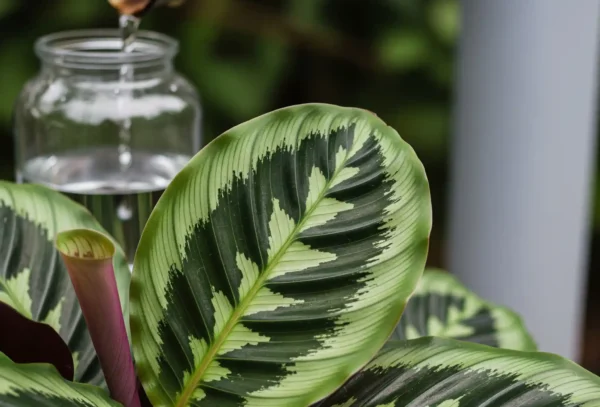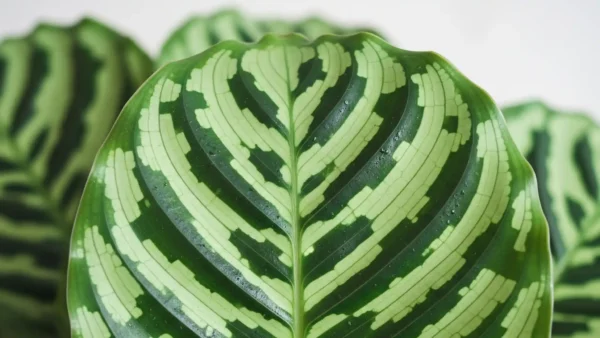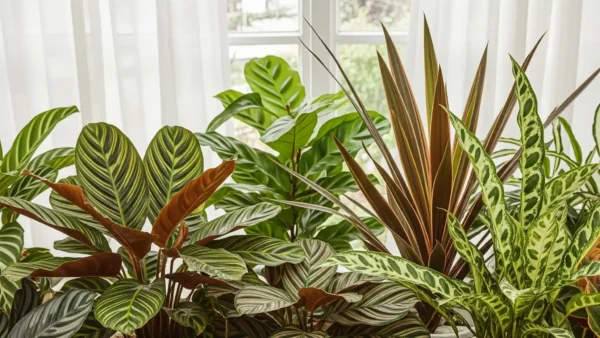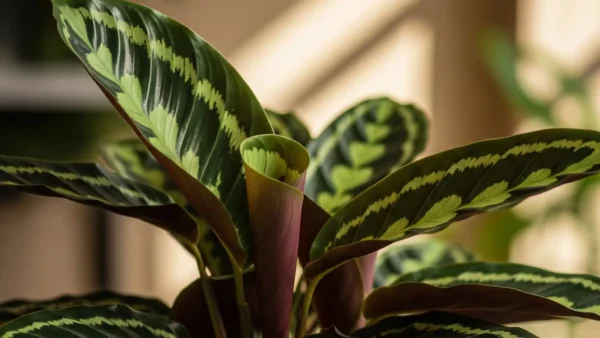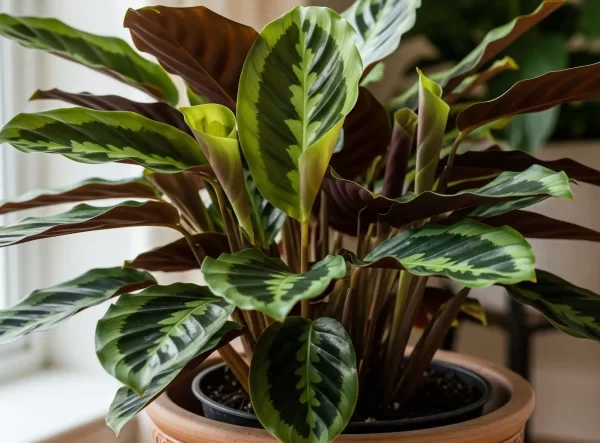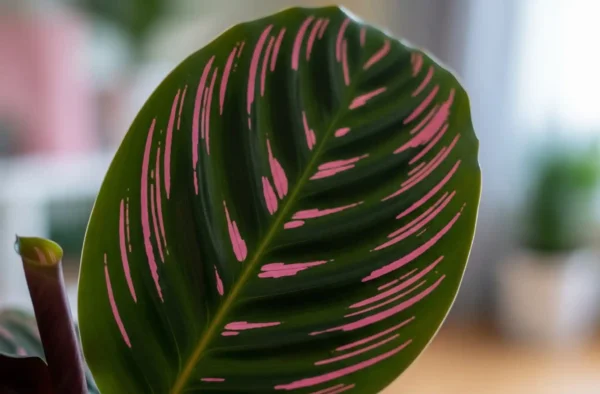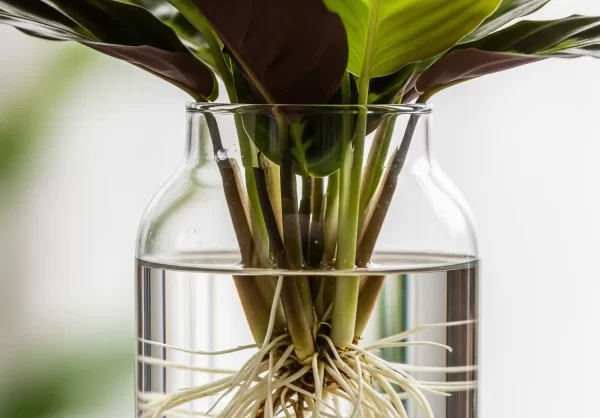How to Fertilize Calathea Without Burning It: A Complete Scientific Guide
TL;DR (Too Long; Didn’t Read)
There is only one rule for successfully fertilizing Calatheas: less is more. They don’t need a lot of food, and giving them too much fertilizer is much worse than not giving them enough.
- The Golden Rule: Use less fertilizer than the package says to. Try it at 1/4 strength first and observe how your plant reacts.
- When to Feed: Only feed a plant that is healthy and developing quickly in the spring and summer. You should never fertilize a plant that is dormant, stressed, or dry.
- What to Use: A balanced liquid fertilizer, like 10-10-10, is a good choice. Worm castings and other organic choices are the safest and best because they are very hard to burn with.
- How to Feed: Always give your plant water a day or two before you want to fertilize it. Use the diluted fertilizer solution instead of normal watering until it runs out of the drainage holes.
- Emergency Fix: If you think you’ve put too much fertilizer on the soil (it has crispy brown borders and a white crust), you need to flush it right away by pouring a lot of clean, unfertilized water through the pot.
The Fear of Fertilizing
The painted leaves of a Calathea are a work of art, but they are also known for being sensitive. You are not alone if the idea of adding fertilizer to your already picky plant makes you feel scared. A lot of people are afraid of this since they know that one false move might make the leaves turn brown and crispy and the plant sick. Many people who own plants have watched in horror as their lovely, colorful Calathea slowly died after being fed in a way that was well-meaning but wrong.
This information is here to help you feel more sure and less scared. We’re going to explain the whole thing in simple, practical words, and provide you a failsafe way to feed your Calathea. We want to make sure it gets the exact nutrients it needs to produce thick, healthy, and beautiful leaves without putting it in danger. When you’re done reading this article, you won’t be nervous about fertilization anymore. You’ll know exactly what to do and how to do it.
The Golden Rule for Fertilizing Calatheas: Use Less Fertilizer
Calatheas are light feeders, which is the most crucial rule that all the other advice in this guide is based on. Before we ever touch a bottle of fertilizer, let’s be sure we know this. We need to look at their residence to find out why. In the rainforest where they reside, they stay on the forest floor, where there is a lot of light and moisture. They don’t get their nutrition from rich soil; instead, they get it from a gradual, steady, and very little amount of nutrients that come from the constant breakdown of organic materials like falling leaves, rotting wood, and animal droppings, which are all gently rinsed down by rain. They can’t manage the quick, strong chemical bursts that many commercial fertilizers give off.
The biggest risk you face is not giving your plants too little fertilizer, but giving them too much. This causes a chemical reaction that makes the plant “burn,” which isn’t a burn from heat. Osmosis causes a chemical dehydration process. You may have learned about osmosis in high school biology. It is the passage of water through a semi-permeable membrane from a place with few solutes to a place with many solutes.
Adding too much fertilizer makes the mineral salts in the soil considerably more concentrated. The water in the soil is now “saltier” than the water in the plant’s sensitive root cells. The rules of physics come into play. The plant’s roots pull water out of the plant and into the soil to try to equalize this gradient. This essentially sucks the moisture out of the plant’s roots, which makes them dry out, shrivel, die, and “burn.” At the same time, the plant is sitting in moisture while dying of thirst, which is why we all want to avoid the crispy brown edges and yellowing leaves.
Based on what I’ve seen, a Calathea can survive happily for a long time without any fertilizer, as long as it gets the nutrients it needs from its potting soil. But if you give it too much, it could die in just a few weeks. If you’re not sure, always miss a meal. You can’t fix a burn, but you can always feed it again next month. Your best instrument is patience.
Decoding Fertilizer: Knowing What Your Calathea Needs and N-P-K
It can be hard to choose fertilizer as you walk down the aisle. The N-P-K ratio, which is the three numbers that are easy to see on every package, is the key to cutting through the noise. These statistics show how much Nitrogen (N), Phosphorus (P), and Potassium (K) are in the plant. These are the three main macronutrients that a plant needs. A “balanced” fertilizer with numbers that are around the same (such 10-10-10 or 20-20-20) or one made for foliage plants (like a 3-1-2) is an excellent choice for a Calathea.
Here’s what those letters really do for your plant and why it’s crucial to keep them in balance:
- N—Nitrogen (The Leaf-Maker): This is what makes Calatheas stand out. Chlorophyll, the green pigment that makes photosynthesis possible, is made up of nitrogen. It is also a building block for amino acids, which are the building blocks of proteins. A continuous supply of nitrogen is what makes leaves grow big, green, and healthy. It’s easy to tell if a plant doesn’t have enough nitrogen: the whole thing will look pale and yellowish, and the new growth will be little and weak.
- P—Phosphorus (The Energizer and Rooter): You might think of phosphorus as the plant’s electrical grid. It is very important for moving energy across the plant (in the form of ATP), making strong, healthy roots, and making flowers and seeds. Calatheas don’t need a lot of phosphorus because they are planted for their beautiful leaves, not their big flowers or fruits. It’s not only useless to use a fertilizer with a lot of phosphorus, but it can also hurt the plant by throwing off the balance of nutrients.
- K – Potassium (The Guardian): Potassium controls the plant’s internal systems. It controls the health of the whole plant, helps it use water more effectively by controlling the opening and closing of leaf pores (stomata), and makes the plant’s cell walls stronger, making it less likely to get sick, get pests, or deal with stress from changes in temperature.
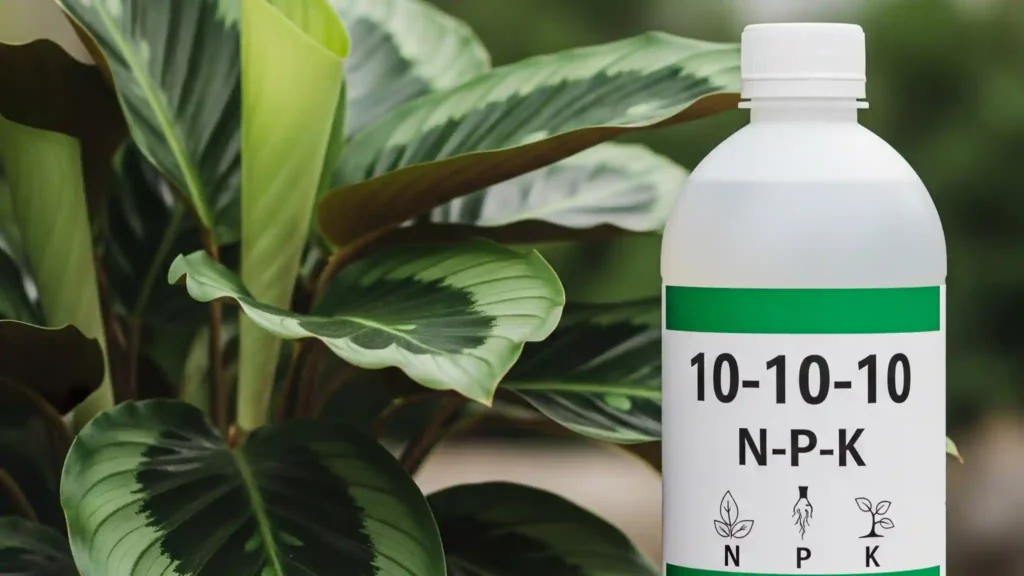
A good fertilizer will also have important micronutrients in it. These are needed in much lesser amounts, but they are still very important. Magnesium (Mg) is the main component in chlorophyll, which gives leaves their green color. Iron (Fe) helps stop a condition called interveinal chlorosis, in which the leaves turn yellow while the veins retain green.
Choosing Your Tool: Natural vs. Man-Made Fertilizers
The kind of fertilizer you use has a big effect on how safe and healthy your Calathea will be in the long run. There are two main groups, and it’s important to know what makes them different.
- Synthetic fertilizers are chemical salts manufactured by people that come in the shape of blue or green water-soluble crystals. They are made to be ready for the plant to use right away. The best thing about them is that they have the right amount of nutrients and work swiftly, which can help fix a specific deficiency. This, however, is also their biggest threat. Fertilizer burns are very easy to start, and because they are made of salt, they quickly build up minerals in the soil, which can hurt roots and break down the structure of the soil over time.
- Organic fertilizers are made from natural things like worm castings, fish emulsion, kelp, or bat guano. They work in different ways and are gentler. They don’t nourish the plant directly; instead, they feed the good microbes in the soil. Then, these bacteria break down the organic stuff into something that the plant can use. This method is slow and delicate, and it makes the soil ecology healthy and alive. With organic fertilizers, it’s practically difficult to burn a plant. The primary problems are that they can smell bad (particularly fish emulsion) and their nutrient ratios aren’t always accurate.

| Feature | Synthetic Fertilizer | Organic Fertilizer |
|---|---|---|
| Speed of Action | Fast / Immediately available | Slow / Gradual release |
| Risk of Burn | Very High | Very Low |
| Salt Buildup | Very High | Very Low |
| Soil Health | Can degrade over time, harming microbial life | Improves soil health and fosters beneficial microbes |
| Best For | Quick results for expert growers (with high risk) | Safe, sustainable, long-term health (Highly Recommended) |
If you’re new to Calatheas, I highly recommend starting with an organic choice like worm castings. During the growing season, you can add a tablespoon of fertilizer to the soil every month or two. This approach of treating your plant is almost impossible to burn, it doesn’t smell, and it helps the soil stay healthy in the long run by making it more aerated and able to hold water. It’s a lot more forgiving way that looks like their native habitat.
A Step-by-Step Guide to Feeding Your Calathea
This is the process that will always work for you. If you follow these procedures in order, you will be able to safely and successfully feed your plant without having to guess.
Step 1: Check the Health Before Fertilizing
You need to do this three-point safety check on your plant before you even consider about adding fertilizer. You can’t move on unless you can agree with all three things. This is the most critical thing you can do to avoid injury.
- Is it growing right now? Look for the signals that fresh growth is happening. A new leaf on a Calathea frequently looks like a tightly curled “cigar” coming out of the middle of the plant. The plant doesn’t need or want food if it stops growing. This could be because it’s in its winter dormancy or because it’s stressed.
- Is it not stressed and healthy? Are there no pests, such spider mites, on the plant? Is it getting better after being moved, repotted, shocked by the temperature, or having root rot? When you fertilize a plant that is already stressed, it’s like making a sick person run a marathon. To stay alive, the plant has turned off some of its non-essential processes, like taking in nutrients for new development. The fertilizer will sit in the ground and become poisonous.
- Is the ground already a little wet? This is the most important step for safety. Do not fertilize a plant that is completely dry. Watering a day or two before planting makes ensuring the roots are full and healthy. This keeps them safe from the first shock and makes sure that the fertilizer solution is mixed into the soil right away, instead of hitting the fragile, dry roots with full, concentrated vigor, which is a definite way to burn the fertilizer.
Step 2: Add more water!
Calatheas are touchy. When fertilizing other houseplants, always use a weaker strength than what the packaging says. You have to do this.
I always start with 1/4 strength. You can always raise the strength to 1/2 if your plant seems to be doing well after a few feedings, but you can’t fix fertilizer burn. The final blend should look like weak tea, not dark coffee. You’ve used too much if it looks dark. If the bottle reads 1 teaspoon per gallon, I use only a little less than 1/4 teaspoon per gallon. It’s preferable to feed the plant four times a month with quarter-strength food than once a month with full-strength food, which could kill it.
Step 3: The Process of Feeding
It’s easy to do now that you have your diluted solution. Instead of watering normally, use the fertilizer mix. Pour it carefully and evenly over the soil, rotating the watering can around to make sure the whole surface is wet. Don’t shower the leaves, because some fertilizers can hurt them. Keep going until the solution starts to flow freely from the holes in the bottom of the pot. This makes sure that all of the roots can get to the nutrients and helps get rid of any little amounts of salt that may have built up from prior waterings.
Step 4: The Schedule: When and How Often
Timing is key. The seasons determine how fast a Calathea grows, which in turn affects how much food it needs.
- Season: Only fertilize during the active growing season, which is usually spring and summer when the days are longer and the plant is generating new leaves. This is when its metabolism is at its highest and it can use the nutrients.
- How often: During this time of year, feed your Calathea every two to four weeks. A plant that grows quickly in a sunny place could need to be fed every two weeks, while one that grows slowly in a darker spot might only need to be fed once a month. Paying attention is important.
- Dormancy: Don’t fertilize at all in the fall and winter. The plant’s growth slows down naturally when the amount of light it gets decreases. It goes into a condition of rest and doesn’t need the extra nutrients. One of the most common mistakes is to fertilize a plant that isn’t growing. This only adds extra salt to the soil, which will sit there and become harmful over time.
Advanced Maintenance: How to Flush Your Soil to Keep Salt from Building Up
This is the trick to keeping your Calathea healthy for a long time, especially if you use synthetic fertilizers or have hard tap water. Even when you dilute them properly, salts will still build up in the soil over time. Flushing is the easy but important step of getting rid of these salts.
- The “Why”: It’s like striking a reset button on your soil. Over time, salt can build up in the soil and render it hazardous. It can also elevate the pH to levels where nutrients are “locked out,” which means the plant can’t use them even if they’re there. It can also cause root burn. Flushing breaks up these mineral salts that have built up and physically washes them out of the pot, letting the roots work normally again.
- The “How”: Every three to four months, or whenever you detect a white crust building on the soil, bring your plant to the sink or bathtub. Pour a lot of clean, unfertilized water (distilled or rainwater is preferable) through the pot slowly and carefully. The amount of water should be around four times the size of the pot. Let it trickle out of the openings in the drainage system. You are cleaning the dirt literally.
- The Benefits: This easy technique stops chemical burns, fixes pH levels that have been messed up by salt buildup, and opens up the pathways that roots require to get the nutrients they need. It’s typical for the plant to look a little limp for a day while it gets used to the new soil conditions.
Help! A Guide to Common Fertilizer Mistakes
Don’t freak out if you think you’ve made a mistake. This is how to figure out what’s wrong and fix it.
Signs that you have over-fertilized
You can easily see the signs if you know what to look for, and they usually show up within a week or two after feeding:
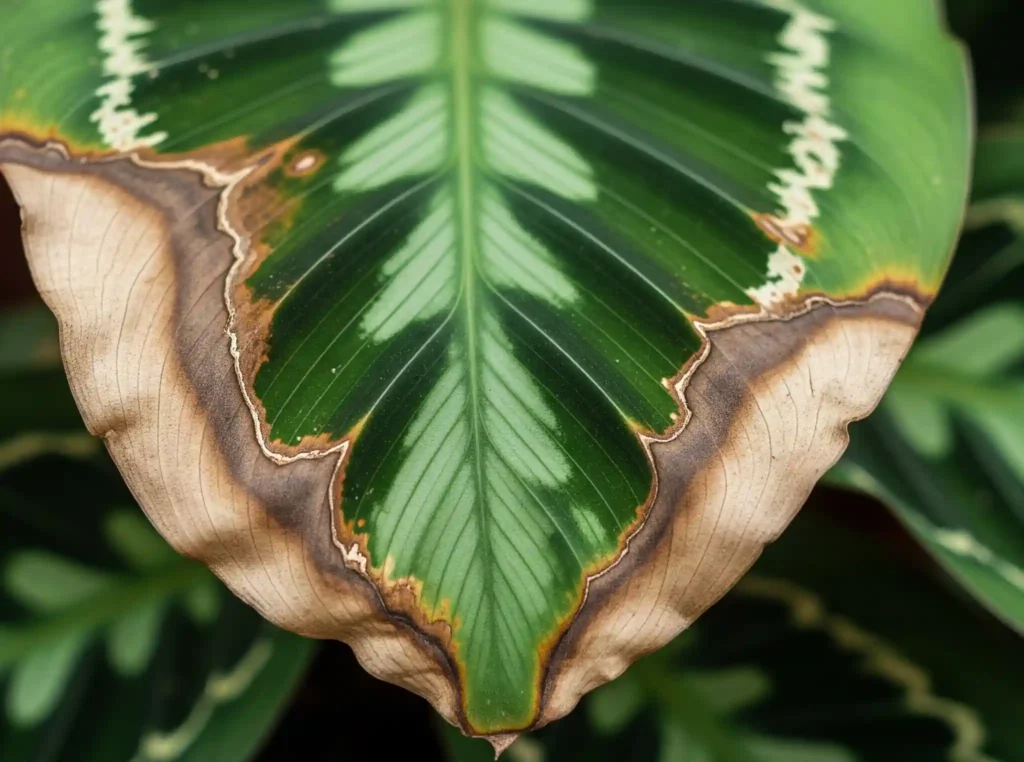
- The tips and edges of the leaves are brown, dry, and crispy. This is the most common indication of root burn.
- Lower leaves that turn yellow and fall off rapidly. The plant is getting rid of its older leaves to try to rescue itself.
- A crusty white salt deposit on the surface of the soil or around the holes in the pot for drainage. This is the extra salt from the fertilizer that is left behind when the water has dried up.
- New growth that is tiny, stunted, or not right. The plant’s roots aren’t healthy enough to support its growth.
- There isn’t much growth, and sometimes the plants even die, even when the soil is wet. This means that the roots are badly hurt and can’t take in water anymore.
How to Save a Plant That Has Too Much Fertilizer
- Flush the soil right away. The first thing you need to do is flush the soil thoroughly, as explained in the last section. This is the most important measure to take to limit the harm. It will wash away as much of the extra fertilizer as possible.
- Stop all feeding. Give the sensitive roots plenty of time to heal and grow back by not fertilizing the plant again for at least 2–3 months. The plant needs some time off.
- Last Resort: Repot. If the burn is bad and flushing doesn’t help, you might need to put the plant in new soil altogether. You can give the plant a brand new start by gently rinsing the old, dirty soil off the roots with lukewarm water while you do this. This is a stressful job, so only do it if you have to.
What if you don’t give enough fertilizer?
This happens far less often and is less harmful. The indicators are less obvious and show up over a longer time. They include a uniform, pale green or washed-out yellowing across the whole plant (unlike the splotchy yellow of overwatering), very slow or completely halted development during the peak of the growing season, and new leaves that are notably smaller than previous ones. If you detect these indicators and haven’t fertilized in a while, it could be appropriate to start a mild feeding schedule with a quarter strength.
In Conclusion: Your Calathea Will Be Grateful If You Feed It Gently
You don’t have to worry about fertilizing a Calathea. You can give them everything they need if you know that they are light eaters and like a patient, steady approach that matches their jungle home. Keep in mind the main rules: fertilize only when the plant is healthy and growing well, and do it only once a week. When you can, pick safer organic solutions. Also, don’t forget to flush the soil every so often as part of your regular maintenance. The most important thing for your plant to do is to watch it closely.
Frequently Asked Questions (FAQ)
Is it okay to apply worm castings or other organic top dressings?
Yes, for sure. This is one of the safest and best ways to add fertilizer. Just sprinkle a tiny layer (like 1–2 tablespoons for a 6-inch pot) on top of the soil and mix it in gently with the top inch of soil every month or two during the growing season. Every time you water it, it will gently release nutrients. You may also prepare “worm tea” by putting some castings in water overnight and then using that water to feed your plant.
Should I give a new plant from the nursery fertilizer?
No. It’s better to wait. A lot of nursery soil has a slow-release fertilizer in it that looks like small green or blue spheres (prills) in the soil. These can give you nourishment for months. To avoid overloading a new plant, wait as least three to six months after taking it home before starting your own fertilizer schedule.
What is the optimal N-P-K ratio for Calatheas?
A safe bet is a balanced ratio, say 10-10-10, diluted. A formula with a little more nitrogen (N), like 3-1-2, is also great since it helps the leaves that Calatheas are grown for. Don’t use “bloom booster” recipes that have a lot of phosphorus.
The leaves of my Calathea are yellow. Is it plant food?
It could be fertilizer burn, but most of the time it’s a symptom that the plant isn’t getting enough water (typically too much). Overwatering can cause yellowing that is splotchy and can happen to any leaf. Fertilizer burn, on the other hand, usually starts with the bottom leaves. Always look for problems with watering first. Before blaming fertilizer, check the roots for rot and the soil moisture deep in the pot.
Can I use spikes of fertilizer?
No way. One of the worst things you can do for a Calathea is use fertilizer spikes. They are meant to dissolve slowly, however they make “hot spots” of fertilizer that are quite strong in one part of the pot. Any roots that touch these places will get very burned. They are the exact reverse of the careful, even, and thin feeding that Calatheas need to grow well.
Sources
- Frontiers in Plant Science. (2024). Optimizing tobacco quality and yield through the scientific application of organic-inorganic fertilizer in China: a meta-analysis. https://www.frontiersin.org/articles/10.3389/fpls.2024.1500544/full
- Confirms the benefits of combining organic and inorganic fertilizers for balanced nutrition and improved plant health, supporting your recommendation for organic options like worm castings and the importance of balanced N-P-K ratios1.
- MDPI Agronomy. (2024). Characteristics of the Soil Microbial Community Structure under Long-Term Chemical Fertilizer Application in Yellow Soil Paddy Fields. https://www.mdpi.com/2073-4395/14/6/1186
- Demonstrates that long-term use of chemical (synthetic) fertilizers can degrade soil health and microbial diversity, reinforcing your advice to prefer organic fertilizers for Calatheas2.
- MDPI Plants. (2024). Influence of Organic and Inorganic Fertilizers on Tea Growth and Quality and Soil Properties of Tea Orchards’ Top Rhizosphere Soil. https://www.mdpi.com/2223-7747/13/2/207/pdf?version=1704967083
- Shows that integrated and organic fertilization improves plant growth, leaf quality, and soil health, supporting your guidance on using organic amendments and balanced N-P-K for foliage plants3.
- MDPI Agronomy. (2024). Effects of Long-Term Fertilizer Application on Crop Yield Stability and Water Use Efficiency in Diversified Planting Systems. https://www.mdpi.com/2073-4395/14/5/1007
- Confirms that organic and combined fertilization strategies enhance yield stability and water use efficiency, echoing your advice to water before fertilizing and to flush soil to prevent salt buildup4.
- MDPI Plants. (2024). Microbial Organic Fertilizer Combined with Magnetically Treated Water Drip Irrigation Promoted the Stability of Desert Soil Aggregates and Improved the Yield and Quality of Jujubes. https://www.mdpi.com/2223-7747/13/14/1930
- Provides evidence that microbial organic fertilizers (like worm castings) improve soil structure, plant health, and reduce risk of fertilizer burn, supporting your recommendation for gentle, organic feeding5.
- MDPI Water. (2018). Quantification of Daily Water Requirements of Container-Grown Calathea and Stromanthe Produced in a Shaded Greenhouse. https://www.mdpi.com/2073-4441/10/9/1194/pdf?version=1536140484
- Offers data on Calathea water needs, supporting your advice to water before fertilizing and to avoid fertilizing dry plants6.
- Hindawi. (2014). Micropropagation of an Exotic Ornamental Plant, Calathea crotalifera, for Production of High Quality Plantlets. http://downloads.hindawi.com/journals/tswj/2014/457092.pdf


